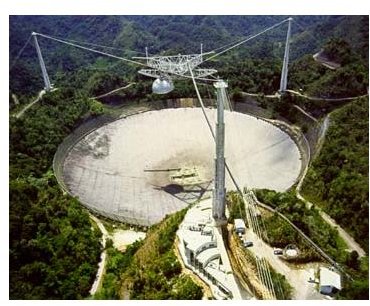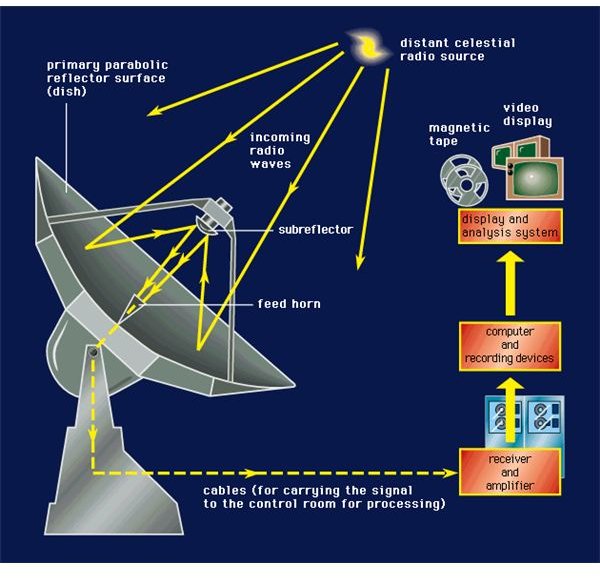Nothing But the Facts About Radio Astronomy
Radio Telescopes:
General: Radio telescopes are a technology that receive naturally occurring radio waves from astronomical objects such as stars, planets, etc.
What do Radio Telescopes Detect?: Radio telescopes are picking up radio waves which are a form of electromagnetic energy (EM), and so happen to be no more enigmatic than light, they just have longer wavelengths, in fact the longest wavelengths for any type of EM energy. Light waves have higher frequencies (shorter wavelengths) and are capable of being detected by the organs of our eyes; infrared radiation, another type of EM, cannot be seen but can be felt as heat. (Check out the article: What’s Really Out There in the Night Sky to see how some celestial objects appear at different EM frequencies.)
Also to be noted here, if there is any confusion, is that radio waves are not sound waves. Sound waves cannot travel through a vacuum because they require pressure changes in matter to propagate. Radio waves are simply a type of electromagnetic radiation. The radio waves transmitted around our globe that we receive on our radios are sound waves converted into radio waves.
Sensitivity and Wavelengths Received: They can study signals with wavelengths between 30 meters and 1 millimeter. SIgnals with wavelengths above 10 meters become heavily distorted in the ionosphere, the uppermost layer of the atmosphere. Radio telescopes on the surface of the Earth have difficulty in receiving these wavelengths, and suffer from a phenomenon known as scintillation, which is a radio equivalent to the twinkling of stars we see in the optical range.
The angular resolution of dish antennas depends on the wavelength of observations divided by the diameter of the dish. And, even with the largest antennas and the shortest wavelengths, the angular resolution is around one arc minute.
Process of Reception: The style of telescope we are most familiar with is the “dish-like” telescope, the dish being something more technically known as a “parabolic antenna,” which serves to focus incoming radiation to a single point, usually an antenna called the feed, which then transfers the signal to the receiver.
Basic Structure: Radio telescopes are a diverse lot in structure, but most have two basic parts: First, a large antennae, and second, a sensitive radiometer or radio receiver. Beyond that, because the radio spectrum of EM radiation is so broad, the structure of telescopes shows a wide variance. For instance, at wavelengths around 3 to 30 meters, because the wavelengths are so long the reflector (large antenna) can be made with mesh-like materials, even chicken wire, and can look similar to large TV antenna; at shorter wavelengths, the dish structure is predominant.
Some Advantages of Radio Astronomy: Radio waves can travel through certain things such as cosmic dust more easily than light waves so scientists can study certain parts of space that might otherwise be too obstructed for light to penetrate and reach us on Earth. Scientists also use radio waves to study the Cosmic Microwave Background, the early universe, remnants of the Big Bang. They have also exposed certain objects in space such as quasars and pulsars that were otherwise unknown to astronomers.
Noteworthy Names in the History of Radio Astronomy:
Karl Jansky: Is credited with “discovering” the first radio waves coming from astronomical objects. While working for Bell Labs on a project concerned with transatlantic telephone service, he experimented with “short waves” (roughly 10-20 meters), and encountered some interference, which he researched more by building a large antennae on a rotating dish, thus allowing him to discover the directional source of the interference. Jansky discovered the source of the interference to be two types of thunderstorms (small and large) and another unrecognizable type, which later was discovered to be radio waves emitted from the Milky Way. He wanted to research further into these cosmic waves, but was not able to because Bell was not interested, they had found out all they needed from his research relating to transatlantic radio communication.
Grote Reber: Built his own radio telescope after learning of Jansky’s discoveries at Bell Labs. Reber tried to get hired at Bell and at other places but it was during the Great Depression and no one was really hiring.
John Kraus: A contemporary of Jansky and Reber, Kraus designed and built a radio telescope at Ohio State University in the 1950’s for approximately $250,000 dollars, with the help of graduate and undergraduate students. The telescope still survives and is called the “Big Ear.” Kraus also wrote a book titled “Radio Astronomy,” published 1966, which is called the “bible” for the field of radio astronomy. Kraus, deceased in 2004, was also interested in discovering extraterrestrial intelligence.
Largest Radio Telescope on Earth: Arecibo Observatory located in Puerto Rico, which is run by Cornell University in conjunction with the National Science Foundation. The diameter of the dish is 305 meters, the depth is 167 feet, and it covers an area of roughly 20 acres.

Noteworthy Discoveries: The most well known discovery of radio astronomy was the discovery of the cosmic microwave background; other discoveries include radio galaxies, pulsars and masers.
Notable Facts, Information Relating to Radio Astronomy: Of the ten astronomers who have won the Nobel Prize in Physics, six of them used radio telescopes for their work. And for a bit of advocacy for radio astronomy and radio pollution, one major issue that radio astronomy faces and could continue to face in exponentially exacerbated conditions, is that of radio interference. Just as optical astronomy can be blinded or saturated because of different kinds of interference, radio astronomy faces all kinds of interference from various sources of radio transmission; which interference, because the radio waves from astronomical objects are relatively very faint given the distance of their sources, and the telescopes made to be highly sensitive, can appear very strong, nearly overwhelming the astronomical information.
Image Credits
1. Radio Telescope Illustration: https://www.skyscan.ca/images/radio_telescope.gif
2. Arecibo Observatory: https://www.news.cornell.edu/Stories/April05/Arecibo72.jpg
